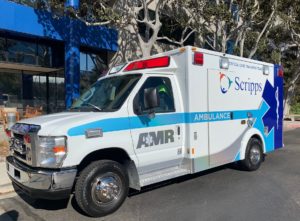Daily Business Report-Aug. 22, 2019
Photo courtesy of Sanford Burnham Prebys Medical Discovery Institute.
$4.96 million grant awarded to Sanford
Burnham Prebys to help the tiniest patients
The California Institute for Regenerative Medicine (CIRM) has awarded a $4.96 million grant to Sanford Burnham Prebys Professor Evan Y. Snyder, M.D. to allow Snyder to complete studies leading to a potential treatment for newborns who experience oxygen and blood-flow deprivation during birth.
Called perinatal hypoxic-ischemic brain injury (HII), the lack of oxygen and blood flow to the brain can cause cerebral palsy and other permanent neurological disorders.
“In the past 25 years that I have worked with these critically ill newborns, the only treatment advance for HII has been therapeutic hypothermia—or whole-body cooling—to prevent brain damage,” says Snyder, professor and director of the Center for Stem Cells & Regenerative Medicine at Sanford Burnham Prebys. “When my lab first isolated human neural stem cells in the 1990s, I immediately thought of their potential to help these children.”
Of every 1,000 babies born in the U.S., two to four experience HII. Possible causes range from umbilical cord compression and disrupted maternal blood pressure to early separation of the placenta from the uterus.
______________________

Discovery may help define new
strategy for treating eye disease
Many forms of vision loss stem from a common source: impaired communication between the eye and the brain. And at the root of all eye-to-brain communication are the hundreds of proteins generated by the retina’s nerve cells.
A new study in Cell Reports examines these proteins in unprecedented detail, providing surprising new insights into how visual signals are distributed to different regions of the brain. The results are an important first step in understanding and eventually treating vision loss from glaucoma, multiple sclerosis or even trauma. More than 3.3 million Americans aged 40 years and older are either legally blind or have visual impairments that can’t be corrected with today’s interventions, according to the Centers for Disease Control and Prevention.
“Proteins are usually the targets of drugs—so if you want to design a drug that will help communication between the eye and the brain, it helps to know what proteins those drugs would target,” says Hollis Cline, co-chair of Scripps Research’s Department of Neuroscience, who led the research project. “This type of study was never possible before because it wasn’t feasible to see how these proteins move around the brain. The technology didn’t exist.”
To create the technology, Cline’s lab worked closely with the lab of John Yates III, a Scripps Research chemist who has pioneered new ways to use an analytical technique known as mass spectrometry to study proteins and their functions.
______________________
City selects Anaheim Arena Management to operate Pechanga Arena
sdnews.com
The group that owns the San Diego Gulls minor hockey league team, Anaheim Arena Management (AAM), has been selected by the City of San Diego to replace Pechanga Arena’s current operator, Arena Group 2000, as arena manager following a request for proposals (RFP) process.
Read more…
______________________

Mt. Helix residential parcel sold
to accommodate 36 estate homes
Shea Homes has acquired a 28-acre residential land parcel for $6.5 million with plans to develop the Fuerte Ranch Estates, a community of 36 estate homes. The property is located at the southeast corner of Fuerte Drive and Damon Lane in El Cajon.
Colliers International’s San Diego Land Team represented the seller, RP Communities LLC.
______________________
FDA accepts application for novel
immunotherapeutic for prostate cancer

Calibr, the drug development division of Scripps Research, announced that the U.S. Food and Drug Administration (FDA) has cleared its investigational new drug application (IND) for CCW702, a novel immunotherapeutic for the treatment of patients with metastatic castration-resistant prostate cancer.
It has the potential to be effective in patients who have failed prior treatments and have exhausted their treatment options, because it works differently than traditional chemotherapeutics and androgen deprivation therapies, according to Travis Young, vice president of Biologics at Calibr, who led the pre-clinical development of the molecule.
Clinical development will be led by Calibr’s new Chief Medical Officer Pamela D. Garzone. Her leadership will be critical as Calibr advances additional programs into the clinic over the next 18 months, with another IND filing expected by the end of the year.
______________________
ALS Association to benefit from
‘Challenge Me Slot Tournament’
The inaugural “ALS Challenge Me Slot Tournament,” a charity fundraiser benefiting the ALS Association Greater San Diego Chapter, will be held from 10 a.m. to 4:30 p.m. on Sunday, Aug. 25, at the Valley View Casino & Hotel, 16300 Nyemii Pass Road, Valley Center.
The public is invited to participate at the fundraiser, which will include cash prizes and prizes presented to the tournament’s top scorers. No previous slot tournament or casino experience is required to participate in this charitable event.
Player donation is $100 per person, which includes tournament participation, a Maine lobster buffet and commemorative windbreaker jacket. All proceeds will benefit the ALS Association Greater San Diego Chapter’s Care Services Initiative, which provides a variety of services to people living with ALS and their families.
More than $10,000 will be awarded to the tournament’s top scorers, including a $2,500 cash grand prize and his-her Citizen watches donated by Unicorn Jewelry in Rancho Bernardo.
______________________
New policy prohibits micro-mobility devices on SDSU campus
Beginning fall 2019, the use of electric or motorized dockless scooters, bicycles, roller skates, hoverboards, skateboards and other micro-mobility devices is prohibited on the San Diego State University campus.
Students will be able to use the alternative transportation source to commute to and from campus, but they are not permitted to operate the devices within university grounds, with the exception of eight designated parking areas.
“The new policy was enacted to ensure the safety of our campus community was a top priority,” said Parking and Transportation Services Director Debbie Richeson. “However, we recognize that micro-mobility is a favored and accessible form of alternate transportation and we want to support this mode of transportation to and from campus.”
______________________
Scripps Health launches region’s first
specialty critical care transport team

Scripps Health has become the first health system in San Diego County to launch a specialty care transport program for adults that is focused on the continuum of care of some of the sickest patients at Scripps hospitals.
Under the program, critically ill patients who require transport between Scripps facilities will be managed by experienced Scripps critical care nurses and accompanied by an American Medical Response (AMR) ambulance crew.
Having a specialty critical care transportation team on hand 24 hours a day, 365 days a year, ensures that patients are safely transported with the most appropriate level of on-board medical care.
The program was launched in partnership with AMR, which provides emergency and non-emergency medical transportation services throughout San Diego County and across the nation. AMR provides the ambulance that transports the critical care patients and the emergency medical technicians who run the vehicle.
The critical care transportation program represents a $1 million investment by Scripps to enhance the level of care that can be provided when a critically ill patient must be moved from one facility to another.



